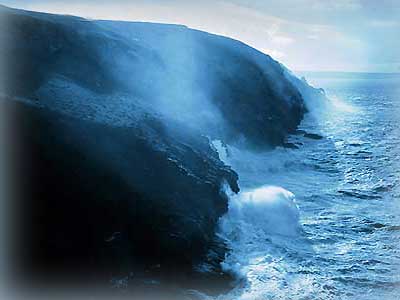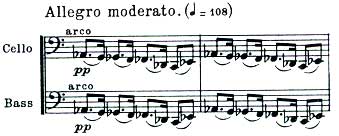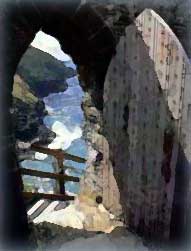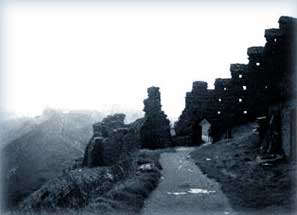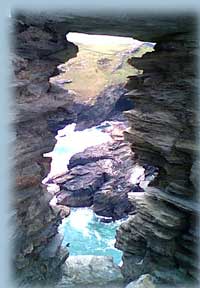TINTAGEL on Record A survey by Christopher Webber
TINTAGEL on Record
A survey by Christopher Webber
THE SIR ARNOLD BAX WEB SITE
Created 13th December 2003
Revised 17th May 2007
If Bax’s name means anything to the average concert-goer, it will most likely be for one work alone – Tintagel. This fifteen minute tone poem has been the first port of call for many who have gone on to chart a course through heavier Baxian seas, and it’s hardly an exaggeration to say that during the thirty years following his death Bax was Tintagel, and Tintagel Bax.
I – HISTORY
Nowadays, with three complete cycles of the symphonies and a plethora of tone poems readily available on CD, it’s tempting to minimalise Tintagel’s importance. Many Baxians would place it down the pecking order, behind not only the symphonies but also at least two other major tone poems, November Woods and The Garden of Fand. This may be in part a reaction against Tintagel’s popularity, or its comparative lack of musical complexity; but would be well to remember that, since its premiere under Dan Godfrey and his Municipal Orchestra (today’s Bournemouth Symphony Orchestra) in the town’s Winter Gardens on 20th October 1921, it has been easily the most played of Bax’s concert works.
It also remains far and away the most recorded. The first major Bax orchestral recording was Tintagel, under Eugene Goossens in 1928; and although it had to wait another twenty-five years for its next studio outing, since 1953 new recordings have regularly appeared on LP and CD. Fifty years on fourteen versions have been issued commercially, nearly all still in the catalogue, some in multiple couplings. Most of them are very good, too – Tintagel is it seems unsinkable.
Unlike many Bax pieces which tease with hints at a biographical agenda, the inspiration behind Tintagel is up front and entirely personal – a Cornish holiday taken late in summer 1917, with his lover Harriet Cohen. The experience was translated into musical form with, for Bax, singular directness and lack of formal complication. Perhaps its drafting helped clarify his mind. At any rate he was soon to make the decision to leave wife and children for his pianist-muse, and Tintagel directly reflects both the physical exhilaration of erotic fulfilment and the mental turmoil which the composer was undergoing.
For this is no simple seascape. The natural phenomena Bax described in his programme notes – “the wide distances of the Atlantic as seen from the cliffs of Cornwall on a sunny but not windless summer day” – are not the main matter. Rather, they form a dramatic backdrop for a powerful battle waged in heart and mind. The more turbulent, complex and chromatic central section may or may evoke “memories of the historical and legendary association of the place, especially those connected with King Arthur, King Mark, and Tristram and Iseult”, but all their stories, significantly, revolve around just such love triangles as Bax himself was experiencing.
Nor is it any accident that Wagner’s Sick Tristan motif from that most erotic of all operas saturates the score, representing as it does the hero’s struggle between self-gratification and self-sacrifice. Bax’s programme note speaks disingenuously of “a brief reference”, but in truth once Sick Tristan is with us, about five minutes into the piece, his debilitating emotional influence is felt until the very last page. Tintagel works its magic on two levels, and an outstanding performance must deal as convincingly with Bax’s stormy central inscape as it does with his bright and breezy seascape, if it is to maintain momentum and amount to more than just a maritime picture postcard. That is the challenge of this deceptively simple work.
II – ANALYSIS
The very first bars of Tintagel give the lie to the idea that its composer was a vague romantic. With breathtaking precision Bax the orchestral imagist paints the breakers pounding rhythmically (string ostinato) way below the castle (cellos and horns), whilst flecks of sunlight (harp) glint on the deep swelling Atlantic waters (double basses), and a gull (flute 3) wheels above in the steady breeze (flutes 1 and 2, plus 1st violins).
The tempo is marked “very moderate … Broad and stately” though the metronome marking of crochet=68 (later 72) suggests a wider range of possibilities. Most conductors raise the curtain impressively, whether at the statelier (Davis, Handley) or livelier (Boult, Barbirolli) ends of the spectrum. The surging waves are most graphically depicted by Barbirolli, though when the heavy brass sally forth to ride them in triumph (a motif by reason of its kinship with Wagner’s Valhalla and Smetana’s Vysehrad perhaps associated with the proud castle ramparts) it is Thomson’s Ulster horns who are most magisterial. The Munich and Virginia brass (for Bostock and Falletta) may not harness such power, but their controlled restraint is effective, too. Even thus early, Lloyd-Jones’ main problem is apparent, his Naxos recording struggling to capture the full range of Bax’s sonorities.
The extra detail of the Chandos recordings for Thomson and Handley, like Lyrita’s for Boult, make the most of Bax’s orchestral filigree as we climb towards the cymbal-clashing climax of this mighty first paragraph. Orchestral balance is specially crucial throughout Tintagel, and neither Lloyd-Jones’ nor Bostock’s effectiveness here is enhanced by weak, inaudible violins.
Although this splendid opening is by no means a mere “prologue to the swelling act”, it is well to hold something in reserve for Bax’s expansive main tune, one of the most generous he ever wrote, a deeply-felt love-theme if ever there was one – Tintagel was publicly and privately dedicated to Harriet. Introduced initially on hushed flutes and violins, its distinct rhythmic triplet and yearning, wide melodic intervals are never long absent from the texture thereafter; though the tune only emerges in full orchestral glory after the heart-searchings of the central section.
Its first appearance is phrased with moving sensitivity by Falletta, though the plainer readings of Downes, Davis and Handley impress too. The swift Goossens, Weldon and Boult for Decca are much more heart-on-sleeve; but perhaps Barbirolli best conveys its pent-up erotic charge, caressing it lovingly here and later, each time it raises its lovely head above the turbulent waters.
Sudden squalls launch themselves in brief sections marked by Bax “considerably faster” led by some predatory brass, and the turbulent central section begins. The alternating Tempo I. is marked a little faster than the opening, but few conductors take advantage of Bax’s dramatic temporal switchbacks around this point as the skies darken and the tension mounts. The no-nonsense Goossens (like Boult and Barbirolli) tends to homogenise Bax’s tempi, Thomson smoothes things out with a surplus of transitional rubati, Bostock is hampered by tardy orchestral responses. Falletta observes Bax’s markings closely, to good effect, though with their slower overall pulse both Davis and Handley take notice of them too.
Soon the chromatic Sick Tristan makes his first appearance, on unison oboe and solo violin. Bax marks Wagner’s motif “plaintive and wistful” but adds the admonitory “crochet=72” marking – in other words, the composer does not invite any indulgent wallowing, but wants the crucial first appearance to be taken at the basic pulse.
Boult treats the ailing hero with businesslike professionalism in both his readings, Barbirolli and Weldon tend him more sympathetically. A stormy dialogue between Sick Tristan and the love-theme begins, with carefully layered dynamics helping clarify the contest. A stern, fugal Allegro moderato on the Tristan motif marks an important stage of the contest, but few conductors take the opportunity to quicken the pulse at this point and some hang fire. Barbirolli launches the fugato with febrile intensity, Bostock encourages some ear-catchingly vigorous phrasing from his lower strings which certainly makes a fair stab at conveying Bax’s “freshly”. Lloyd-Jones is dynamically flat, and Thomson’s gradations aren’t too distinct either – the Chandos engineers adding a disturbing edit for good measure as his fugato begins.
Falletta and Handley best convey its pianissimo threat, and both build convincingly to the feverish climax of the piece, as Sick Tristan bursts out Allegro con brio, his Wagnerian instrumental colour and counter-rhythms intact. Falletta’s Allegro is certainly con brio, dancing rather than careering through the orchestra, but her speed is what Bax asks for. The less nimble Barbirolli’s chromatic intensity is searing, unlike the fussily phrased Thomson and Bostock, both bogged down in detail at this point. Davis and Handley perhaps get the best of both worlds, unleashing the full force of the emotional storm without sacrificing any of the Allegro’s energy.
Passion ebbs, and soon the flutes introduce a Vltava-like minor-key ostinato motif in thirds, pouring oil on troubled waters and reasserting consciousness of the natural world. Handley is peerless here, bringing out cello and viola counterflows quite marvellously, as Bax prepares the way for the long-delayed triumph of his love-theme, clothed for the first time in full orchestral glory. Nearly everyone makes this work, yet though the conductors who paid most attention to Bax’s tempi and dynamic shadings in the central section make their mark here – Davis, Handley and Falletta – paradoxically it is Barbirolli, living for the moment, who once again has the highest emotional charge.
After this moving climax, the remaining difficulty is to avoid having Bax’s post-coital postlude slacken too much, as poor Tristan and his moral doubts are finally lulled to sleep. The problem is that the final coda – a straightforward, brief, fortissimo reassertion of the opening seascape – can seem either obvious or unmotivated if too much of a meal is made of the wind-down. Barbirolli is not immune to this, whilst Lloyd-Jones’ and Bostock’s players sound relieved it’s all over. At the other end of the spectrum there is an Olympian grandeur to both Davis’ and Handley’s coda which is most impressive. Both convey a sense of the transcient tragedy of human emotions being subsumed by the larger, eternal drama of the wind and waves. That perspective constitutes the final triumph of Bax’s masterly tone poem.
III – THE RECORDINGS
1. New Symphony Orchestra/Eugene Goossens
Symposium CD 1336, Dutton CDBP 9779 (12:00)
The first, major Bax orchestral recording still impresses by reason of Goossens’ iron control, urgency and sense of drama. His no-nonsense dispatch – possibly (like the excision of the first two bars of the fugato illustrated above) occasioned by the need to squeeze the work onto two 78rpm sides – precludes poetic introspection, but is always exhilarating. Although much detail goes missing the 1928 recording was good for its time, so more shame that Symposium’s bald transfer doesn’t do it any justice. Surface noise is horribly distracting, especially around the side turn, and so it’s difficult to recommend the CD for general listening. Luckily the 2007 Dutton transfer is infinitely better, revealing more detail under the mush without any sense of over-processing, and with no audible side-turn.
2. London Symphony Orchestra/George Weldon
Dutton Laboratories CD CDCLP4002 (14:45)
Dutton’s transfer does well by Columbia’s very early LP, which is notably better balanced than Boult’s more or less contemporary Decca reading. In some ways, this plays against Weldon’s strength, for his conducting is strong on atmosphere, weaker on rhythmic articulation and ensemble. He is not alone in equating Bax’s repeated “very quiet” markings with “very slow”, and despite its sensitive musicality his performance suffers from slack momentum through the crucial middle sections. The final climax emerges somewhat limply as a consequence, and the performance runs out of steam.
3. London Philharmonic Orchestra/Sir Adrian Boult
Belart 461 3542, Decca 4730802 (13:28)
Boult’s mono reading is strong and swift, with more fire in its belly than his Lyrita remake. His opening paragraph is amongst the most sweeping on record, his statement of the love-theme straightforward but sympathetic. Although he pays scant attention to Bax’s tempo markings in the stormy central section, the results are far from unmotivated and the orchestra is inspired to a moving peroration. Decca’s recording, warm but mushy on Belart, comes up clean but wiry on the in-house transfer, which emphasises a patch or two of lacklustre playing. Neither has much dynamic range, but Boult’s performance transcends such limitations.
4. London Symphony Orchestra/Sir John Barbirolli
EMI CDM5 65110-2, EMI CDC 7 47984-2, HMV 5 68469-2,
5757902 (boxed set: ‘Barbirolli Collection’), EMI 0946 79984 2 (‘Great Recordings of the Century’) (14:54)
Barbirolli’s reading, like Weldon’s with the same orchestra, is characterised by warmth, sensitivity and a powerful sense of drama. His opening paragraph, with every line clearly audible, conveys an exciting sense of anticipation, and no other conductor moulds the love-theme so passionately. Flexible, romantic expression does not rule out controlled shaping, and Barbirolli builds surely to a very broad climax, from which the lingering sunset-glow of the postlude flows most naturally. Not everything is perfect. There is some sour pitching from the trumpets and the final chord is not quite sweetly tuned; some central episodes don’t avoid a dragging sense of ennui. Still, for its beauty and epic sweep this much-loved recording remains a benchmark; and its 2007 incarnation (a well-merited appearance in EMI’s Great Recordings series) restores the sense of space – particularly around the brass – which had gone missing in the earlier, somewhat congested-sounding CD issues.
5. London Philharmonic Orchestra/Sir Adrian Boult
Lyrita SRCD231 (13:17)
Marginally faster even than his mono version Boult’s Lyrita recording does not lack majesty or momentum. Surprisingly this is a maverick amongst modern recordings, with many unmarked accelerandos whipping up the surf throughout. It’s gripping enough, never brusque, with everything clearly audible – maybe too much so, for instrumental co-ordination and execution are sometimes no better than workmanlike. More seriously, Boult’s hustling now betrays a lack of engagement with the deeper structural needs of the piece. The engineering remains amongst the best, impressively full and dynamic.
6. Ulster Orchestra/Bryden Thomson
Chandos CHAN9168, CHAN8312, CHAN6538, CHAN 7047 (14:55)
Broadly played and beefily recorded, Thomson’s version starts as impressively as any. The Ulster horns are specially thrilling, and though not all instrumental lines are fully audible the opening makes a strong effect. In the darker, central section tempi are too homogenised – for example, Thomson speeds up through the initial appearance of the Sick Tristan motif into the brass “squall”, thus smoothing out Bax’s carefully graduated emotional switchbacks. There is a lack of attention to dynamic markings, too, and a blurring of orchestral detail; all of which produces a sense of stasis to work against the undeniable power of the whole.
7. BBC Philharmonic Orchestra/Sir Edward Downes
BBC Radio Classics 15656 9159-2 (14:03)
After a grand, measured opening, the BBC PO’s understated presentation of the love-theme gives the clue to Downes’ approach, which puts clean articulation before poetry or drama. It’s a grittily determined approach which builds to a stirring climax. Balance isn’t ideal in the closing pages, where some coarse brass overwhelms the strings, but otherwise both recording and performance are worth seeking out.
8. BBC Symphony Orchestra/Sir Andrew Davis
BBC CD MM63 (free with BBC Music Magazine November 1997) (14:34)
The BBC captured this Tintagel at a live concert in Athens, but the sound – some transcient woodwind and harp inaudibilities aside – is clear and full. Davis’ stately reading boasts Athenian virtues. His initial tempo is quietly dignified and well maintained throughout. He sticks much closer to the letter of Bax’s own tempo and dynamic markings than most of his rivals, orchestral balance is good and climaxes impeccably prepared. This is satisfing, absorbing music making which makes it point, though in the last analysis the tang of the sea – wine-dark or otherwise – is hard to scent.
9. Munich Symphony Orchestra/Douglas Bostock
Classico CLASSCD254 (14:36)
Clear, lively recording, solid architecture and the odd interesting detail give some credence to the Munich version. Broadly conceived, very much in the manner of Thomson, Bostock’s attention to Bax’s tempo markings is commendable, but his sense of shape is scuppered by weak strings, forensic playing and some messy ensemble. The final impression is of a tentative run-through rather than a fully engaged performance.
10. Virginia Symphony/JoAnn Falletta
Hampton Road Classics HRC004 (Virginia Symphony direct sales) (14:47)
Falletta impresses through impeccable ensemble and scrupulous care over Bax’s markings and orchestral balance – though her Tintagel lacks nothing in warmth or expressive detail. The Virginia brass in particular play with virtuoso dynamic restraint, so that the relatively small-toned string section are never overwhelmed. Although there’s a lack of power at the big climaxes, this performance is musically satisfying in just about every other respect; and with its clear but far from antiseptic recording it deserves a far wider circulation.
11. Minnesota Orchestra/Sir Neville Marriner
Centennial Commemoration 12-CD box set (available direct from MO) (15:10)
Live concert (27th September 1985). This is not available on a separate CD, but only as part of the expensive complete set. No great loss, as Marriner and his Minnesotans are beefy and inclined to torpor. Interest in the central section flags well before the undeniably exciting recapitualtion, not helped by a washy in-house acoustic.
12. Royal Scottish National Orchestra/David Lloyd-Jones
Naxos 8.557145 (14:29)
Lloyd-Jones follows Bax’s tempo markings scrupulously, but the RSNO never get out of first gear. Their version is marred by sloppy rhythmic articulation, flat dynamics and lacklustre ensemble – heading into the recapitulation there seems some real danger of disintegration. Weird engineering compounds the problem, playing its own game of scissors-stone-paper – the strings are drowned by the woodwind, the woodwind by the brass. The opening pages register as a vague hum, the violins are frequently inaudible, and the Allegro con brio Sick Tristan motif at the heart of the piece sounds fatally limp, as if the hero were dead rather than delirious. Altogether this is a most disappointing filler for the last in the Naxos symphonic cycle.
13. BBC Philharmonic Orchestra/Vernon Handley
Chandos CHAN 10122 (15:08)
Handley shows how much can be achieved by simply following the score. Rhythms and ensemble are crisp, tempi rock-solid, dynamics finely gradated. The horns, for example, really begin pianissimo, helping distil an opening paragraph which though not so adrenal as some rivals, excels in magic. Surprisingly, given its conductor’s present penchant for brisk Bax, this is the slowest Tintagel on disc; but imaginative phrasing and near-perfect orchestral balance ensure that details register, without any loss of momentum. It holds. Climaxes are impeccably prepared, and – one missed trumpet note apart – the playing is faultless, with the surging, contrapuntally-placed violins specially effective at the top and tail of the piece. The lucid, full sonic picture does justice to Handley’s careful shaping of the piece, making this a very desirable version indeed.
14. Hallé/Mark Elder
Part of “English Landscapes”, CD HLL 7512 (16:57)
At nearly 17′ this is the slowest Tintagel on record, and though the grandeur is initially compelling, the turbulent central section soon runs out of steam and the return to the opening seascape is disappointingly flat. Elder’s iron control matches Handley’s on Chandos but misses his sense of architectonic inevitability, let alone Barbirolli’s surging tides of emotion. Elder’s is a cool, precise reading which never amounts to more than the sum of its sonically impressive parts.
IV – SUMMARY
Tintagel has been lucky on record. Though it certainly does not play itself, many readings – notably the mono Boult and Andrew Davis’s noble live performance – are well worth seeking out. Falletta’s Virginia version is specially commendable for its detailed musicality and fidelity to Bax’s markings. Nonetheless, Vernon Handley’s BBC PO account is the first in thirty-five years to rival the classic LSO version under Barbirolli. Some may find Handley a fraction clinical, but whilst he may not encompass the fevered, heart-on-sleeve beauty of Barbirolli at his best there’s a case for arguing that his ear for detail and faultless pacing sustains the work better through to the end.
So much for the cold light of reason. Ultimately, the warmth of the older version makes it impossible to put aside – Barbirolli, more fully than any conductor before or since, grasps the human passion at the heart of Bax’s Tintagel.
© Christopher Webber 2003, 2007

